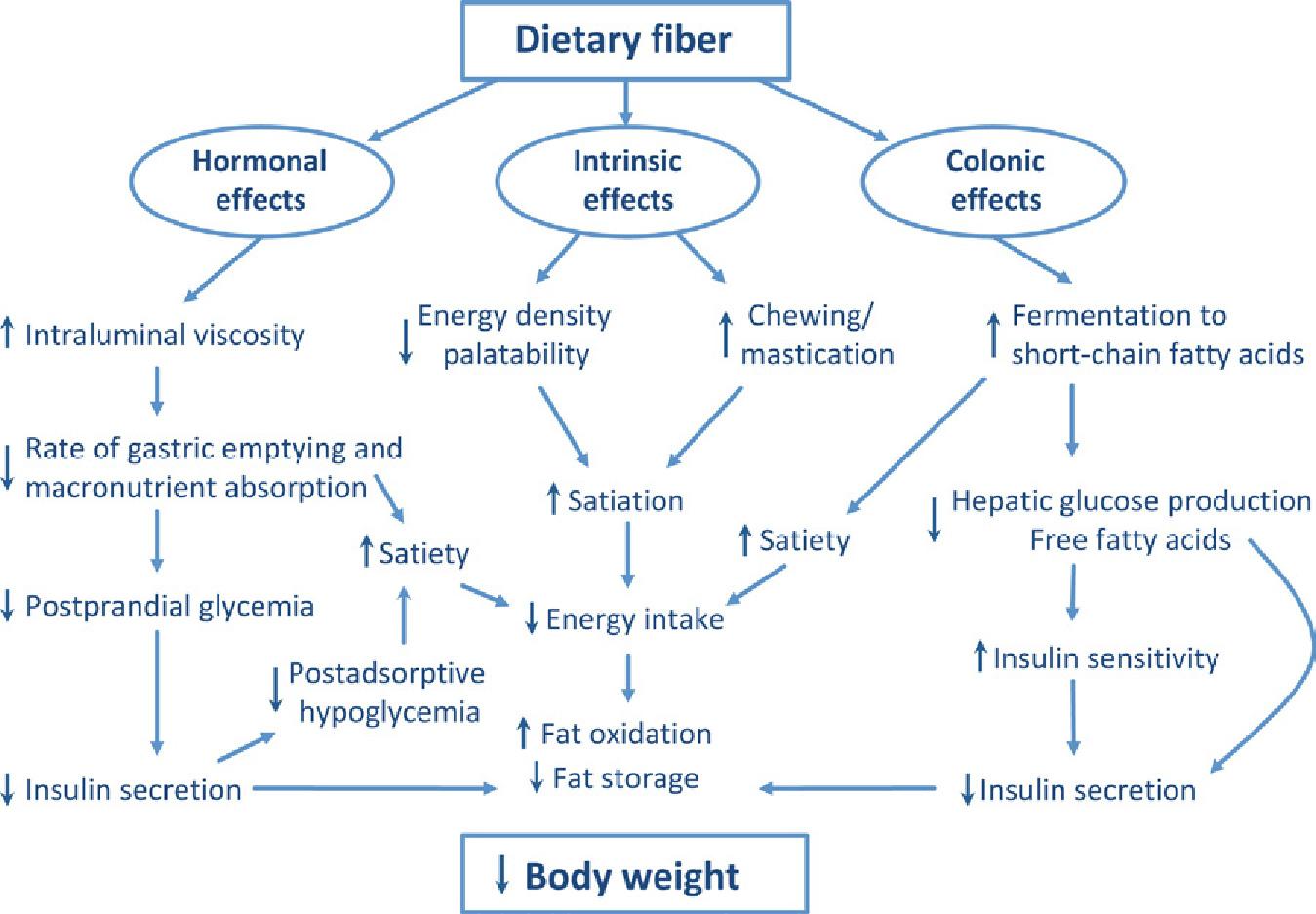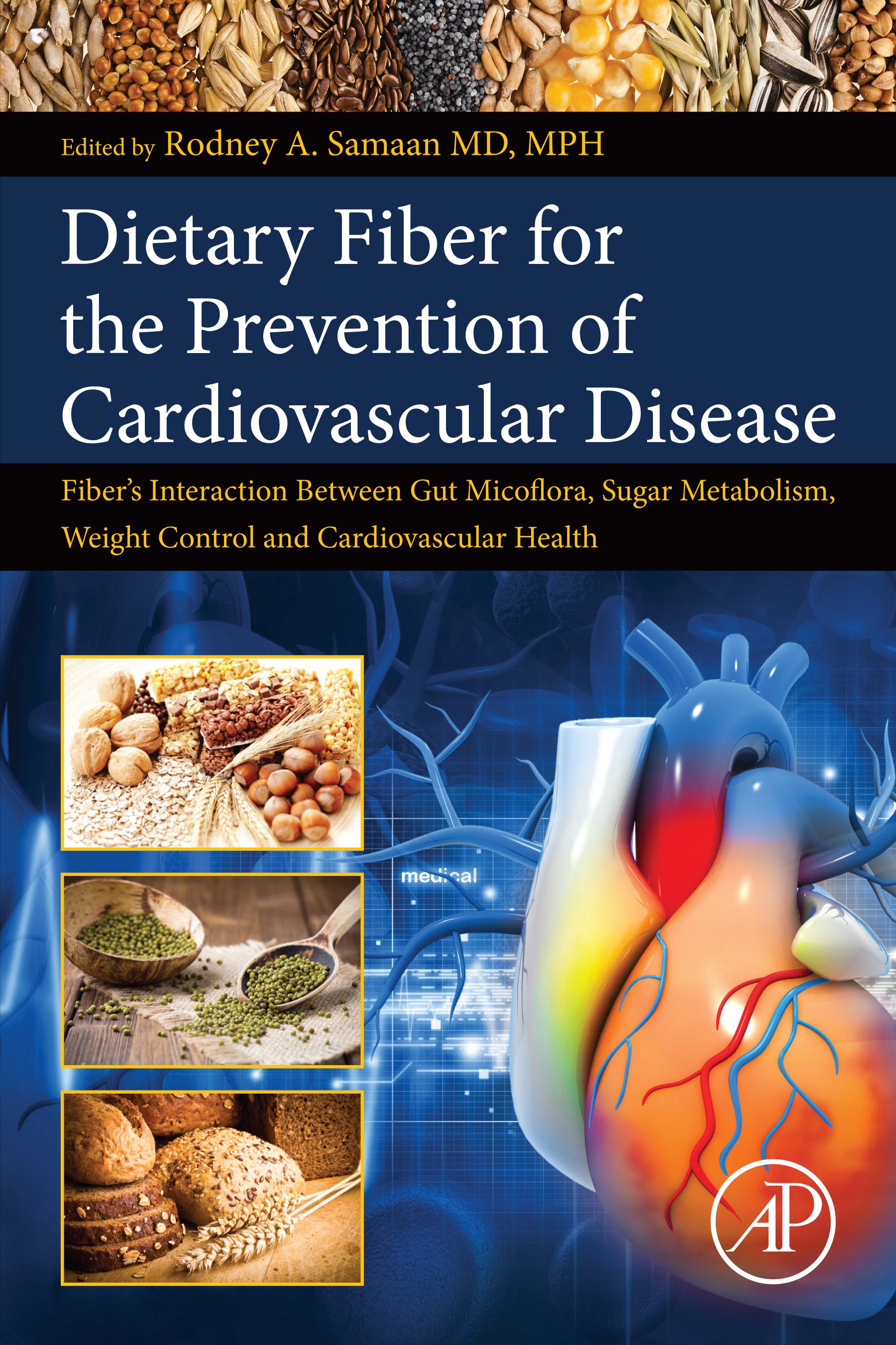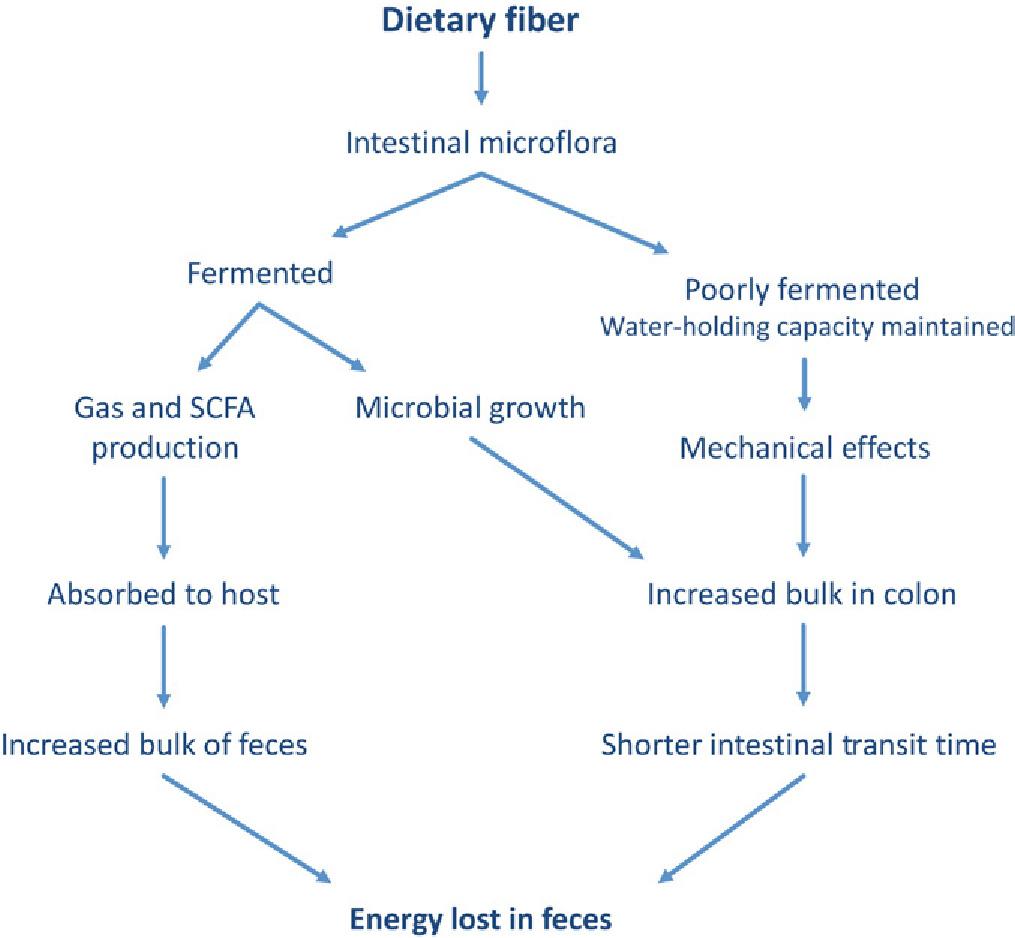Dietary Fiber and Human Health: An Introduction
Santosh K. Jha, Hare R. Singh, Pragya Prakash
1 INTRODUCTION
Fibers are the structural part of a plant and are found in all plant foods, including vegetables, fruits, grains, and legumes. Dietary fiber is a discrete group of carbohydrate found almost exclusively in plants, including nonstarch polysaccharides (NSPs), such as cellulose, pectin, and lignin. It is the edible integral element of carbohydrate and lignin that is naturally found in plant food. Most dietary fibers are polysaccharides are starches, but they are not digested by humans. Starch is a long chain of glucose molecules linked together with alpha bonds. Fiber is a long chain of glucose molecules linked together with beta bonds. The human body lacks enzymes to break beta bonds, therefore fiber is not digested and absorbed. The undigested fiber passes into the lower intestine where intestinal bacteria can ferment the fibers.
Fibers are typically known as NSPs. NSP fibers include cellulose, hemicellulose, pectin, gums, and mucilages. Dietary fibers act by changing how other nutrients and chemicals are absorbed. Some varieties of soluble fiber absorb water to become a gelatinous, viscous substance that is degraded by microbes in the digestive tract. Some types of insoluble fiber have bulking action and are not fermented. Lignin, a significant dietary insoluble fiber may alter the rate and metabolism of soluble fibers. Some other types of insoluble fiber, notably resistant starch (RS), are fully fermented. Some but not all soluble plant fibers block intestinal mucosal adherence and translocation of potentially pathogenic bacteria and may therefore modulate intestinal inflammation, an effect that has been termed contrabiotic.
The occurrence of the fiber depends on the sources and origin. For example, in vegetables, fiber is mainly concentrated on the skin, but trace amounts are found in the rind too, while in cereals it is mainly found in the bran portion, whereas in fruits it is not only present in the skin but
Dietary Fiber for the Prevention of Cardiovascular Disease
http://dx.doi.org/10.1016/B978-0-12-805130-6.00001-X Copyright
Table 1.1 A classification of the unavailable carbohydrates in foods [1]
Major sources in the diet
Structural materials of the plant cell wall
Nonstructural materials, either found naturally or used as food additives
Description
Structural polysaccharides
Noncarbohydrate constituents
Polysaccharides from a variety of sources
Classical nomenclature
Cellulose, some pectins, and hemicellulose
Lignin, minor constituents
Pectins, gums, mucilages, algal polysaccharides, chemically modified polysaccharides
also in the fruity portion named the mesocarp. Dietary fiber usually refers to the unavailable carbohydrates, and is mainly classified as soluble and insoluble. The insoluble fibers are present in fruits, vegetables, grains, legumes, and cereals. The soluble fibers include pectin, gums, certain hemicelluloses, and storage polysaccharides. Fruits, some vegetables, oat, barley, soybeans, psyllium seeds, and legumes contain more soluble fiber than other foods.
The American Association of Cereal Chemists (AACC, 2001) defined dietary fiber as: “the edible parts of plants or analogous carbohydrates that are resistant to digestion & absorption in the human small intestine with complete or partial fermentation in the large intestine. Dietary fiber includes polysaccharides, oligosaccharides, lignin, and associated plant substances. Dietary fiber promotes beneficial physiological effects including laxation, blood cholesterol attenuation, and blood glucose attenuation.”
These unavailable carbohydrates can be categorized into two major groups, based on the structural components as shown in Table 1.1.
2 T YPES OF DIETARY FIBER
Dietary fiber comprises cellulose, noncellulosic polysaccharides (NCPs), such as hemicelluloses, pectic substances, and a noncarbohydrate component lignin. These are mainly the structural components of the plant cell wall. Some types of plant fiber are not cell wall components, but are formed in specialized secretory plant cells including plant gums. Gums are sticky exudations formed in response to trauma. Mucilages are secreted into the endosperm of plant seeds where they act to prevent excessive dehydration and include materials with widespread industrial applications, such as guar gum.
2.1 Soluble Versus Insoluble Fiber
Chemists classify fibers depending on how promptly they dissolve in water, so these can be categorized as soluble fibers and insoluble fibers. The insoluble fibers act as a sponge within the gut by absorbing water. This will increase the softness and bulk of the stool and will thereby decrease the chance of constipation, and colon carcinoma [2]. Scientists have conjointly recommended that soluble fibers can reduce glucose levels and hence prevent diabetes [3]. Foods containing fiber often have a combination of both soluble and insoluble fibers. Diets rich in soluble fiber includes dried beans and oranges. Insoluble fibers include whole wheat (wheat bran) and rye.
The Institute of Medicine recommends that the terms soluble and insoluble fibers should no longer be used to classify dietary fibers even though they may still appear on some food labels. Both are considered to be functional fibers; nondigestable carbohydrates have beneficial physiological effects in humans. Another new term is total fiber, which is the sum of dietary fiber and functional fiber [4].
2.1.1 Common Fibers
The most common fibers are cellulose, hemicellulose, and pectic substances. A few other types of fiber include vegetable gums, inulin, beta-glucan, oligosaccharides, fructans, some RSs, and lignin. Lignin belongs to the class of the fibers that are not carbohydrates [4]
2.2 Polysaccharides
Cellulose, the foremost verdant molecule found in nature, is the beta compound of starch; it is a long (up to 10,000 sugar residues) linear compound of 1,4 joined units of glucose. Hydrogen bonding between sugar residues in adjacent chains imparts a crystalline microfibril structure; cellulose is insoluble in robust alkali. NCPs embrace an oversized variety of heteroglycans that consist of a mixture of pentoses, hexoses, and uronic acids. Among a lot of vital NCPs are hemicellulose and cellulose substances [5]. Hemicelluloses are cell wall unit polysaccharides solubilized by a binary compound alkali after the removal of water soluble and cellulose polysaccharides (Table 1.1). The hemicelluloses are subclassified on the premise of the principal monomeric sugar residue. Acidic and neutral forms differ by the content of glucuronic and galacturonic acids. Uronic acid formation involves the reaction of the terminal ─CH2OH to ─COOH, and is of biological importance since the sugar residues become obtainable for methylation, amidation, and formation of ion complexes [6]. Hemicelluloses, particularly the simple

Figure 1.1 Physiological effects of dietary fibers [15].
nonimmunological processes. There is an increasing proof that fermentable dietary fibers and the new delineated probiotics could modulate numerous properties of the system, as well as those of the gut-associated lymphoid tissues (GALT).
3.1.1 Proposed Mechanisms: Immunomodulating Effects of Dietary Fibers
• Direct contact of lactic acid bacteria or bacterial products (cell wall or cytoplasmic components) with immune cells in the intestine.
• Production of short-chain fatty acids from fiber fermentation.
• Modulation of mucin production.
3.1.1.1 Direct Contact of Lactic Acid Bacteria or Bacterial Products (Cell Wall or Cytoplasmic Components) With Immune Cells in the Intestine
It is typically assumed that the consumption of prebiotics, through their effects on the colonic microflora, can have an analogous impact as probiotics on the performance of the immune system. Studies have documented the effects of feeding carboxylic acid bacterium (i.e., Lactobacilli and Bifido bacteria) on varied parameters of immune function. Oral
The initial event upon exposure of fiber to an aqueous medium is surface adsorption of water molecules. Particle size may additionally influence the water retention capability of fiber [25–27]. Robertson and Eastwood have demonstrated that the fiber preparation alters the water retention capabilities. This implies that the physical structure of fiber is the most significant determinant of hydratability.
3.4 Adsorption of Organic Materials
Adsorption of digestive fluid acids has been best documented and relies on the composition of the fiber, the chemistry of the steroid, and therefore the pH and osmolality of the encompassing medium [28,29]. Lignin is the most potent steroid adsorbent, and binding is seemingly influenced by mass, pH, and therefore the presence of methoxyl and α-carbonyl groups on the lignin molecule [30]. Eastwood and Hamilton [31] demonstrated that methylation of polymer accumulated steroid sorption. These authors conjointly reported that adsorption was greatest at low pH. Each condition would either block or suppress ionization of carboxyl groups and hydroxyl groups on lignin’s phenyl propane units, suggesting a hydrophobic bonding mechanism. These studies predict that interaction with lignin is greater for bacterially changed digestive fluid acids shaped within the colon. Saponins conjointly bind bile acids in vitro [32] and in vivo [33], and they may be responsible for sterol adsorption related to fiber. However, bran and alfalfa showed no diminution of adsorbent capability following removal of associated saponins [34]
3.5 Cation Exchange Properties
The useful capability of dietary fiber for ion exchange is well established. The impact is expounded to the amount of free carboxyl teams on the sugar residues [35,36]. Calcium binding is foretold on the premise of uronic acid content of fiber residues [37]. Formation of ion complexes with acidic polysaccharides is mirrored in their effects on mineral balance, solution absorption, and significant metal toxicity.
3.5.1 Quantifying Fiber Content
Several completely different laboratory strategies are used to measure the quantity of fiber in foods. The older technique consisted of treating a food with robust acid to simulate the surroundings of the abdomen, so treating it with a base to parallel the experience within the small intestine. The remaining weight of undigested fiber was measured as “crude fiber” and was listed in most food composition tables as “fiber.” This rather inaccurate
Table
1.4 Dietar y fiber profile of foods [39]
Food source
Breads, cereals, and pasta
Cornflakes 1 cup
White bread 1 slice
White rice 1/2 cup cooked 0. 5 0.5 0.0
Brown rice 1/2 cup cooked 1.3 1.3
Spaghetti 1/2 cup cooked 0.8
Bran (100%) cereal 1/2 cup
Rolled oats 3/4 cup cooked 3.0 1.3 1.7
Oats, whole 1/2 cup cooked 1.6 0.5 1.1
Corn grits 1/2 cup cooked 1.9 0.61 0.3
Popcorn 3 cups 2.8 0.8 2.0
Fruits
Grapefruit 1/2 fruit
of the overall energy intake. The population goal is 55% from carbohydrates that ought to be used for designing purposes. The intake of refined, supplemental sugars should not exceed 10%.The Health Council of Netherlands [41] supported their recommendations for light carbohydrates [42]. A sugar intake above 55 seems to be related to risk of dyslipidemia (e.g., exaggerated VLDL and small HDL-cholesterol).
The German–Austrian–Swiss recommendations are discussed in Ref. [43]. It is stressed that carbohydrates ought to be derived from foods rich in starch and dietary fiber, and intake of refined sugars ought to be restricted. In order to avoid gluconeogenesis from macromolecule (e.g., amino acids) and to inhibit lipolysis, a minimum of 25% of the energy ought to be provided from carbohydrates. This proportion applies to all ages. No quantitative recommendation was created for (added) sugars.
WHO offers population nutrient intake goals (population average intakes that area unit judged to be in step with the upkeep of health in a very population) for preventing diet-related chronic diseases [44]. For carbohydrates the population goal is ready at 55–75%, together with dietary fiber. A recent FAO/WHO Scientific Update on saccharide within the human diet proposes that the variation is extended to 50–75% [45]. The
UK Committee on Medical Aspects of Food Policy [46] set a dietary reference (population average intake) for starches and intrinsic and milk sugars of 37%. For nonmilk sugars the population average intake must not exceed 60 g/day, primarily based on the role of frequent consumption of such sugars. The US Food and Nutrition Board calculated the typical demand of (glycemic) carbohydrates as 100 g/day for youngsters and adolescents up to 18 years, further as adults [4], primarily based chiefly on information relating to glucose employment by the brain. The US Food and Nutrition Board additionally set Acceptable Macronutrient Distribution Ranges (AMDR) for total carbohydrates of 45–65% for individuals. The AMDR are supported by a proof indicating an attenuated risk for coronary heart disease (coronary heart disease, CHD) at low intakes of fat and high intakes of carbohydrates.
The Health Council of Netherlands [42] has set tips for the intake of dietary fiber which chiefly supported the importance of dietary fiber for intestinal functioning and its relationship to risk of coronary heart disease. For youngsters a gradual increase in the intake is suggested. It increases as the youngsters move up in age group. The suggested consumption is 2.8 g/MJ for 1–3 years, 3.0 g/MJ for 4–8 years, 3.2 g/MJ for 9–13 years, and 3.4 g/MJ from 14 years of age, respectively. Within the Nordic Nutrition Recommendations, the intake limit of dietary fiber is set as 25–35 g/ day in adults, that is, 3 g/MJ [40]. Adequate intake of dietary fiber reduces the danger of constipation and might presumably contribute to protection against carcinoma. No recommendation is given for youngsters as a result of restricted evidence; however, it is declared that intake of acceptable amounts of dietary fiber from a spread of foods is vital for youngsters. Within the UN agency report of 2003 [44], there’s no precise population goal for the intake of total dietary fiber, rather a minimum of 25 g/ day ought to be provided from fruit, vegetables, and whole-grain foods. This population goal relies on evidence linking high intake of dietary fiber (from fruit, vegetables, and whole-grain foods) with attenuated risk of weight gain, diabetes type 2, and cardiovascular diseases (CVDs). The foodbased recommendation was supported by the recent FAO/WHO scientific update on saccharide within the human diet. Within the biological process recommendations for the French population, intake of dietary fiber of greater than 25 g/day is suggested for maintaining “a healthy colon” and to decrease the danger of carcinoma, with 30 g/day as a most popular level. Also, increased intake of dietary fiber is declared to be advantageous in conditions like dyslipidemia and in diabetes mellitus type 2. The guiding
be thought of "normal". They reported that increasing intake of fiber (provided by a combination of fruit, vegetables, and grains) from 16 to 30 g/day enlarged defecation frequency from 0.7 to 0.94 times per day; an additional increase in fiber intake to 42 g/day had no further result on frequency; it remained at once per day. There was no important amendment over the variation of fiber intakes in gastrointestinal transit time that remained within 2–3 days. Fecal weight enlarged from 109 to 156 g and 195 g at fiber intakes of 16, 30, and 42 g/day, respectively. Increasing dietary fiber intake from 12 to 45 g/day enlarged fecal weight from 69 to 184 g/day and reduced transit time from 70 to 45 h [55]. Mean transit time in UK adults has been reported as 70 h (median 60 h) in a population within which mean stool weight is about 110 g/day, but 100 g/day in about 50% of people and dietary fiber intake of about 18 g/day [51]. It has been calculated that a dietary fiber intake of 25 g/day is related to stool weight of 130–150 g/day [56]. It was rumored that adults consumed 25 g dietary fiber in their usual diet excreted over a 150 g fecal matter per day [52]. Further these data indicate that an intake of 25 g/day of dietary fiber from mixed foods (as AOAC fiber or equivalent) is compatible with internal organ transit time of about 2–3 days and a defecation frequency of once per day and a fecal moisture of greater than 70% may be thought of adequate for most adults (Fig. 1.3).
6.1.2 Fiber in Children
There is evidence that constipation could be more common throughout childhood [57] in which there is an inverse relationship with dietary fiber intake [58]. The fiber intake among 1-year-old German kids was already higher (3 g/MJ) and there are no reports of adverse effects associated with the fiber intake.
In conclusion, dietary fiber intake of 2 g/MJ ought to be adequate for defecation in kids and supported the evidence that the dietary fiber intake is adequate for traditional defecation in adults is 25 g, comparable to 2–3 g/ MJ for daily energy intakes of 8–12 MJ.
6.2 Inhibition of Fat Accumulation
Many authors have examined the potential of a high fiber diet to switch fat oxidization [59], and different studies [60,61] have examined its potential as satiation agent and additionally an ingredient for weight management [62], although the results are still not conclusive. An intake of a diet rich in fiber could increase the mobilization of the fat stores that can be used as a result of a decrease in insulin secretion [63]. Studies to this point in humans
1.3 Effect of dietary fiber over intestinal microflora.
would indicate that diets rich in fiber do not have an effect on total energy expenditure, saccharide oxidization, or fat oxidization [64–67]. In another study on human volunteers, breads rich in fiber imparted higher satiation than white breads taken between 70 and 120 min [68]. Higgins et al. examined the connection between the content of a meal and postprandial fat oxidization, finding that 5.4% of total dietary carbohydrates with fiber may considerably increase postprandial lipid oxidization and possibly cut back fat accumulation in the long run [69]. It had been reported that the employment of fiber within the diet as a bioactive purposeful food element could be a natural endogenous method to reduce energy intake, hence a natural approach to the treatment of obesity [70].
6.3 Absorption of Minerals
Fiber enhanced the ileal absorption of a variety of minerals in rats and humans. Fiber-rich diets increased absorption of calcium, magnesium, zinc, iron, and copper in rats [71,72]. Fiber may have a positive result on enteral calcium and iron absorption. A study to check the apparent enteral absorption of calcium, phosphorus, iron, and zinc within the presence of either resistant or light starch showed that a meal containing 16.4% fiber resulted in a bigger apparent absorption of calcium and iron compared with light starch [73].
Figure









